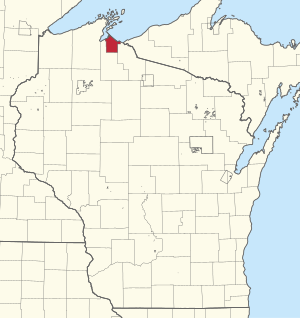Bad River Band of the Lake Superior Tribe of Chippewa Indians facts for kids
| Mashkii ziibii | |
|---|---|

Bad River Band of Lake Superior Chippewas Flag
|
|
| Total population | |
| 6,945 (2010) | |
| Regions with significant populations | |
| Languages | |
| English, Ojibwe | |
| Religion | |
| Catholicism, Methodism, Midewiwin | |
| Related ethnic groups | |
| other Ojibwe, Odawa and Potawatomi |
The Bad River LaPointe Band of the Lake Superior Tribe of Chippewa Indians, often called the Bad River Tribe (in Ojibwe, Mashkii ziibii), is a federally recognized tribe of Ojibwe people. In 2010, the tribe had 6,945 members.
The Bad River Reservation is located on the southern shore of Lake Superior. It covers about 193 square miles (500 square kilometers) in northern Wisconsin. This land stretches across Ashland and Iron counties. Odanah, the tribe's main center, is about 5 miles (8 kilometers) east of the town of Ashland on U.S. Highway 2. In 2020, 1,545 people lived on the reservation. Much of the reservation is covered by forests and wetlands. These areas are important habitats for wild rice and other natural resources.
Contents
History of the Bad River Tribe
According to Anishinaabe stories, the Great Spirit, Gichi Manidoo, told the Anishinaabe people to travel west. They were to keep moving until they found the "food that grows on water." After many stops, a group of Anishinaabe, known as the Lake Superior Chippewa, found wild rice. This was near the Chequamegon Bay on the south shore of Lake Superior. This place is now the Bad River Lapointe Reservation. Their final stopping place was nearby Madeline Island.
After the 1600s, Anishinaabe people settled across northern Wisconsin. This land was once fought over with the Dakota Sioux and the Meskwaki tribes. Those who stayed near the trading post of La Pointe on Madeline Island were called the La Pointe Band. They traded furs with French-Canadian settlers. They also fished, gathered wild rice, and hunted. Women picked berries, made maple sugar, and collected nuts, roots, and medicinal plants.
In the 1800s, the U.S. government tried to move the Lake Superior Bands. This led to a sad event called the Sandy Lake Tragedy. After this, the U.S. government agreed to create permanent reservations in Wisconsin. At this time, the La Pointe band split. Members who followed Catholicism were led by Kechewaishke (Chief Buffalo). They settled on a reservation at Red Cliff. Those who kept their traditional Midewiwin beliefs settled at Bad River. Even today, these two bands remain close.
The land for the Bad River Lapointe Band was set aside in the Treaty of La Pointe. This treaty was signed with the United States on Madeline Island on September 30, 1854. The treaty land included almost 2,000 acres (8 square kilometers) on Madeline Island. This island is seen as a very important place for the Ojibwe Nation. The Bad River Band is one of six Ojibwe bands in Wisconsin today. It is also one of eleven federally recognized tribes in the state.
In the late 1800s, the Franciscan Sisters of Perpetual Adoration started St. Mary's School in Odanah. This was an Indian boarding school. Students from different tribes came to learn English and Western subjects. They also learned about Christianity. During this time, timber companies leased land on the reservation for logging. However, they did not pay the tribe fairly. They also damaged much of the land by cutting down too many trees. During the Allotment period, the tribe leased almost half of its land. This land originally covered all of modern-day Ashland, Wisconsin.
Protecting Tribal Rights
As Lake Superior Ojibwe, the Bad River Lapointe Band has rights to hunt, fish, and gather wild rice. They can also collect medicinal plants in northern Wisconsin, Michigan, and Minnesota. The tribe worked to protect these rights throughout the 1900s. Tribal members from Bad River and other Lake Superior bands began spear fishing again. This led to some disagreements with other fishermen, known as the Wisconsin Walleye War.
In 1996, a group of Ojibwe activists called the Anishinaabe Ogitchida stopped a train shipment. This train was carrying sulfuric acid across the reservation. The acid was going to a copper mine in Michigan. The protestors worried the acid would harm reservation lands and Lake Superior. The protests brought national attention. This made the Environmental Protection Agency stop the use of acid at the copper mine.
The main office of the Great Lakes Indian Fish & Wildlife Commission (GLIFWC) is on the Bad River Reservation. The tribe also runs a fish hatchery. This hatchery puts 15 million walleye fish into local rivers and lakes each year.
The Bad River Band of Lapoint Ojibwe owns and runs a casino on the reservation. They also have the Moccasin Trail gas station and grocery store. The Tribe also provides many services for its people. These include a clinic, local transportation, a tribal school, daycare, and Head Start. They also have their own police and volunteer fire department. The tribe has community buildings like a fire hall and youth center in Birch Hill. There is also a utility garage in Franks Field.
In 2014, the Tribe announced a decision about land leases on Madeline Island. They decided not to renew the leases for 18 non-native people. These leases, which started in 1967, ended in August 2017.
About the Reservation
The Bad River Reservation is mostly on the south shore of Lake Superior. It is almost entirely covered by forests and swamps. The reservation also includes a small part of the eastern tip of Madeline Island. Bad River is the largest Ojibwe reservation in Wisconsin. It is the second largest Indian reservation in the state, after the Menominee Indian Reservation. In the Ojibwe language, the Anishinaabe people who lived around swamps were called Omashkiigowag. This means "Swampy people," from mashkiig meaning "swamp." The people are also called Mashkigonaabeg, which means "Swampy-men."
Reservation Geography
The reservation covers about 197 square miles (510 square kilometers). About 193 square miles (500 square kilometers) is land, and 4 square miles (10 square kilometers) is water. In 2010, less than half of the reservation land was owned by the tribe. The rest was owned by individual tribal members or people from outside the tribe. This was due to past land policies like the Dawes Act.
About 16,000 acres (65 square kilometers) of the reservation are high-quality wetlands. These include the Kakagon Sloughs and Bad River sloughs. The United States government has recognized these as wetlands of international importance. These wetlands are perfect for growing wild rice, which is a traditional food for the Ojibwe. The sloughs are the only large coastal wild rice marsh left in the Great Lakes region. Because of its natural environment and closeness to Madeline Island, Bad River is very important to the Ojibwe Nation. People from all over Ojibwe Country come for the yearly August celebration of manoomin, or the wild rice harvest.
On the northern edge of the reservation, the land is usually between 600 and 700 feet (183 and 213 meters) above sea level. To the south, the land rises to between 700 and 1,100 feet (213 and 335 meters) above sea level. Many small lakes are scattered across the reservation.
People on the Reservation
As of the 2020 census, the Bad River Reservation had a population of 1,545 people. Most people on the reservation live in one of four communities: Odanah (which includes New Odanah), Diaperville (also called Old Odanah), Birch Hill, or Frank's Field/Aspen Estates.
Climate
The Bad River Reservation has extreme weather. Winters are long and cold, while summers are short and warm. Lake Superior greatly affects the climate. In the cold winter months, low temperatures are usually a little above 0°F (-18°C). High temperatures in winter are usually above 20°F (-7°C). In the summer months, average low temperatures are near 50 to 55°F (10 to 13°C). Average high temperatures in summer are between 74 and 80°F (23 and 27°C). There is a lot of rain and snow because of the large forest and Lake Superior. The average yearly precipitation is around 30 inches (762 millimeters).
Notable Members
- Trixie Mattel (Brian Michael Firkus), a famous drag queen and folk musician
- Lyle Mitchell Corbine Jr., a filmmaker




